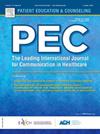Exploring the impact of a pain assessment information visualization tool on provider-patient pain discussion with limited English proficiency Hmong patients
IF 2.9
2区 医学
Q2 PUBLIC, ENVIRONMENTAL & OCCUPATIONAL HEALTH
引用次数: 0
Abstract
Objective
This pilot study examines the impact of the Pain Assessment Information Visualization (InfoViz) Tool on the length of the patient visit for Hmong patients with limited English proficiency (LEP).
Methods
A static design study was used to collect data from a triad of 20 Hmong patients with LEP, medical interpreters, and clinicians in the usual care group followed by 20 triads in the intervention group in primary care. We analyzed patient-clinician communication audio-recorded visits in primary care, examining both the length of the visit and the nature of the clinician efforts to gather more information using Svarstad’s clinician conversation conceptualization to explore probing frequencies for three pain categories: pain location, severity, and quality in the intervention group (Pain InfoViz Tool) and usual care group.
Results
The usual care group spent a longer time on pain discussions (Mean = 19.56 min, SD=20.17) compared to the intervention group (Mean = 12.39 min, SD=7.78). Clinicians in the intervention group probed less than those in the usual care group. Patients in the intervention group provided more pain information to clinicians than those in the usual care group.
Conclusions
The tool appears to shorten the time it takes to discuss the patient’s pain. It may have positively impacted Hmong patients with LEP' ability to describe their pain more clearly, resulting in less time and fewer assessment probes needed by clinicians.
Practice implications
Implementing the tool in clinical settings may lead to more efficient pain-related discussions.
求助全文
约1分钟内获得全文
求助全文
来源期刊

Patient Education and Counseling
医学-公共卫生、环境卫生与职业卫生
CiteScore
5.60
自引率
11.40%
发文量
384
审稿时长
46 days
期刊介绍:
Patient Education and Counseling is an interdisciplinary, international journal for patient education and health promotion researchers, managers and clinicians. The journal seeks to explore and elucidate the educational, counseling and communication models in health care. Its aim is to provide a forum for fundamental as well as applied research, and to promote the study of organizational issues involved with the delivery of patient education, counseling, health promotion services and training models in improving communication between providers and patients.
 求助内容:
求助内容: 应助结果提醒方式:
应助结果提醒方式:


